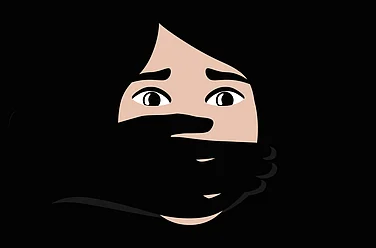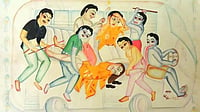Red-light districts are designated geographies for prostitution, made up of brothels and tipple zones (street spaces where sex workers solicit customers), largely inhabited by those engaged in the transactional nature of sex. Over the years, glamorous depictions of these geographies and their residents have become fodder for Indian cinema.
Like Calcutta’s Sonagachi—Asia’s largest red-light district. It was here Satyajit Ray found his Indir Thakrun for Pather Panchali (1955), living in a derelict apartment in penury. In a side plot in the Tamil movie Mahanadi (1994), Kamal Hassan manages to rescue his daughter who is sold to a brothel here. In the Academy award-winning documentary, Born Into Brothels: Calcutta’s Red Light Kids (2004), sex workers’ children from here are taught to use photography as a life-changing skill.
In 2021, a 26-minute film joined this list, looking at Sonagachi and other spots like Fort William, Kidderpore, and Chitpur, that became hubs of sexualised labour. Sex (Work) and the City produced by The Third Eye, a Delhi-based think tank under Nirantar Trust—the same non-profit organisation behind the pioneering all-women rural media collective, Khabar Lahariya. On World Sex Workers Day (June 2) this year, the movie was made available on thethirdeyeportal.in for public viewing free of cost.
Sex (Work) and the City uses the lens of prostitution to chronicle Calcutta’s rapid transformation into a megalopolis after the East India Company established its headquarters here in 1690. Decades of massive upheavals followed. Rural West Bengal saw colonial demands of indigo and tea plantations overthrow an agrarian economy, and women-centric occupations like spinning and weaving, dwindle. Many disillusioned men and women migrated in droves to Calcutta where factories began to populate the banks of The Hooghly, along with traders, merchants and bankers. The influx shook the class system. Suddenly, respectability and culture, not money, took precedence with the rise of colonial education from which the original middle-class benefitted and gained upward mobility. And among those occupying their spot was the public woman. Among the ruralfolk drawn to Calcutta were women who became factory workers and ayyahs (governess) and in their spare time took up sex work. The film states it also included widows, especially the Kulins, highest sub-caste of the Brahmins who fled as they couldn’t cope with the ‘unattainable regimes of chastity’.

On the colonial side of things, several British cantonment soldiers or ‘Tommies’ in colloquial slang, were reeling from syphilis, after liaising with local sex workers. The Tommies were sexually deprived, garrisoned in India for long periods, their own women back home. To ‘placate’ these soldiers and ensure they had ‘clean sex’, the Cantonment Act was announced in 1864 that allowed the Company, to put it casually, ‘pimp’ healthy women to the cantonment bases like Fort William in Calcutta. The sex worker became a medico-legal object, screened for syphilis via ‘violent’ medical procedures. Only the ones certified healthy were passed on to the Tommies.
The efficacy of the law remained only if the Tommies were always at the cantonment base so that the Company had control over the women they sexually engage with. But these officers would travel, be enlisted for short missions across the state, and tracking their sexual escapades during those periods became impossible. The 1868 Contagious Diseases Acts was enforced then to conduct medical examinations of sex workers across Calcutta. ‘Locked hospitals’ were constructed to ‘incarcerate’ infected women till their recovery. The women had no agency over their bodies. The Ladies Association in England got wind of it. Two of their delegates visited Calcutta, and shocked by the brutal implications of the Act, appealed to Queen Victoria to have mercy on ‘her daughters’. The law was revoked in the 1890s. Later, speculations were rife that the Portuguese entering via Kidderpore port could be the carriers of the syphilis as the disease originated in Europe, and merely passed it on to the female sex worker.

As if celebrating that freedom from the colonial grasp, the film next dives into lifestyles of rich sex workers, queens occupying grand kothas and veradahs in Chitpur, who would frown on ‘pen-pushers’, clerks working for colonial bosses, and in one instance, ‘accidentally’ even spit betel juice on one. The last stop is Sonagachi. The cramped, unhygienic, match-box spaces here are a jolt back to reality. Here, the Sonagachi project under Durbar, a sex workers’ collective, was formed to promote safe sex after the women were accused of being HIV/AIDS super-spreaders during the 90s epidemic.
“Unless it was a collective refusal to not do sex work without condoms, the women were unintentionally undercutting each other, as the clients then went to women who would solicit without insisting on protection,” says Dr Paromita Chakravarti, Department of English at Jadavpur University, the sutradhar (narrator) in Sex (Work) and the City and on whose research the film is based. “A resultant condom campaign ensued as a group effort, which led to a call for better working conditions, unionisation, and a new lens to view the sex worker as a rights-bearing individual who also deserves to be protected. And for researchers, the fact that sexuality could be associated with both pleasure and protests was new,” says Chakravarti.

Moreover, this film was made during the Covid lockdowns. “It felt very strange to make the film concerning syphilis and AIDS/HIV during the pandemic. In all three instances, the sex workers bore the brunt as their trade was depended on ‘touch’, which became criminalised during the outbreaks,” says Shabani Hassanwalia, the film’s producer, and editor & producer at The Third Eye.
Within 26 minutes, the film makes many revelations. So many that all end up as touch-and-goes, leaving the viewer wanting more. Like defining what ‘unattainable chastity regimes’ meant, whether it implied sati, practiced on a smaller scale despite the 1829 Bengal Sati Regulation, sexual exploitation by male family members, or deportation to widow homes at holy cities and the uncertain fate thereafter. One is curious how the educated Brahmin woman integrated herself into sex work, how she was treated by sex workers of other classes—Dalit, working-class, and the slew of nautchwalis trained in classical music and dance, who came from crumbling princely courts in provinces like nearby Awadh (Oudh), Agra.

The trauma about undergoing syphilis check-ups is writ large on the faces of the women in copper plate engravings. In one, she is wailing, her hair grabbed by a Tommy, a colonist ready to prod with a finger, and male medico ready to perform surgery; another plate shows a group of hassled women on a boat being chased by a crocodile, and CDA 1968 stamp. But the film doesn’t delve into details of the ‘torturous’ medical procedures. “The infected women,” says Dr Chakravarti when asked to elaborate, “were hosed down with powerful jets of water and disinfectants. Syphilis sores form on and around the gentitals and so every checkup meant the women were forced to reveal themselves to the doctors. The intrusions were conducted in a hurried manner without care if it caused them pain. The women could not leave the locked hospitals till they recovered, which could mean two-three months, the women could not earn any income, which is why many tried to escape.” Inclusion of the fact that infected Tommies were not put through the same rigmarole of check-ups, lock ups and shame, would have demonstrated how patriarchal narratives mostly blame a woman, make her atone alone, for an act beyond her control.
The narrative does not extend to the Criminal Tribes Act 1871 that allowed the Company to perform similar medical check-ups of transsexuals and hijras—a section of whom would join sex work—as it intended to systemically eliminate the community. Chakravarti says her research didn’t extend to the third gender. “Sonagachi largely had cis-gender women sex workers, not many trans and hijras. The hijra akhadas (nodes) where the leader, called amma, designates duties like begging, offering blessings at festivities, sex work, have their own coded language… it’s a whole different grammar, and I didn’t want to get into that.”
The pre-pandemic plan was to shoot at the places mapped in the film. “We wanted to do a guided tour of all the sites where sex workers had been garrisoned; the kothas (brothels), the houses where the Agrawalis and Lucknowalis lived, and the organised layout of the brothels… basically follow the trajectory of how sex work developed in the city, which we couldn’t. Had I moved spatially, there were many stories I could have told,” says Chakravarti.
But Chakravarti’s pedagogical narration and the seamless integration of myriad facts, viewing of the cityscape through the new lens of sex work, and compelling research, ensure the storytelling is never dull. The visuals captivates with paintings, photographs, and maps of colonial haunts where sex work was rampant; reimaginings of the sex trade with actors playing sex workers, dolling up and waiting for clients in the verandah; and even obeisance to classical greats like Begum Akhtar and ‘India’s gramophone girl’—Gauhar Jaan who made Calcutta their home at some point. Here’s hoping for a sequel with Chakravarti conducting a post-pandemic walkthrough in these infamous alleyways.
(This appeared in the print edition as "Down Jasmine-scented Alleys of Memory")


























